#Master Classes in India
Explore tagged Tumblr posts
Text
Mastering 3D Game Art: Advanced Online Courses and Master Classes in India
The realm of 3D game art is continually evolving, pushing the boundaries of creativity and technical prowess. For those aspiring to master this art form, engaging in advanced game art classes online and specialized game art master classes in India can provide a significant edge.
0 notes
Text
Discover Yourself this International Yoga Day with Sattva Connect (June 21, 2025)
International Yoga Day is more than a global trend — it’s a personal reminder to pause, breathe, and realign.
For 2025, Sattva Connect offers a powerful spiritual experience online, open to all. Hosted by the revered Himalayan Master Anand Mehrotra, this online celebration features:
✨ Conscious breathwork and meditation ✨ Vedic mantra practice ✨ Live yoga flows for all levels ✨ Insightful satsangs and community dialogue
This isn’t fitness yoga — it’s an awakening experience.
If you feel disconnected or overworked, join us for this free global celebration.
📅 Date: June 21, 2025 🔗 Sign up: https://sattvaconnect.com/international-yoga-day/
Let’s practice together, globally, in stillness and strength. 🌿
#international yoga day#International yoga day 2025#Yoga Day 2025#Sattva Connect Yoga Day Celebration#Yoga Day Celebration#Sattva Connect#anand mehrotra#Himalayan Master Anand Mehrotra#Sattva Online Yoga Courses#Yoga Courses Online#kundalini yoga#online yoga classes in india#online yoga courses#Yoga & Meditation Courses
0 notes
Text
Master French from Home: Top Online French Lessons for Every Level

Learning French opens doors to new cultures, travel, and professional growth. Today, online French lessons make it possible to master this language conveniently from home, regardless of your proficiency level. With a wide range of online classes tailored for beginners, intermediate learners, and advanced speakers, there’s an option to suit every need and schedule.
Discover Online French Classes in India
For those in India, there are specialized online French classes in India that cater to local time zones and cultural contexts, making the learning process more accessible and comfortable. Indian learners can find classes with native and certified French instructors who understand the unique needs of language learners. These classes often include culturally relevant lessons, conversation practice, and beginner-to-advanced curricula, allowing students to gain proficiency step-by-step.
Why Choose Online French Classes?
Choosing online French classes comes with distinct advantages, like flexibility, personalized learning, and access to high-quality resources. Online classes offer a variety of learning formats — from live, interactive sessions with instructors to self-paced modules with video and audio aids. These classes make it easy to practice pronunciation, improve listening skills, and engage in conversations with other learners or instructors. Additionally, with the freedom to set your own schedule, you can integrate French learning into your daily routine without interrupting other commitments.
Effective Tips to Learn French Online
To make the most of your online learning experience, consider these effective tips:
Practice Consistently: Daily practice, even if brief, builds a strong foundation and helps reinforce new vocabulary.
Use Additional Resources: Leverage language apps, online forums, and media like French podcasts or movies to immerse yourself further.
Engage in Conversation: Many online platforms offer virtual meetups or conversation partners. Practicing with a native or advanced speaker can enhance fluency.
Opting to learn French online offers a customizable experience, where you can choose from a mix of structured classes, multimedia resources, and conversation opportunities to build proficiency at your own pace.
Conclusion
Mastering French from home is now more accessible and effective than ever. With a range of online options tailored for every level, learners can build their language skills flexibly and conveniently. Choose Frenchtree to embark on your language-learning journey, where quality instruction and comprehensive resources meet to make French learning rewarding, enjoyable, and practical.
#Online French Lessons Guide#Master French from Home#Top Online French Classes#French Courses in India
0 notes
Text
Jeetendra Sharma | Concept Artist & Game Designer
Welcome to the portfolio of Jeetendra Sharma, a talented game designer and concept artist. Explore a captivating array of character designs, immersive environments, and engaging visuals that bring game worlds to life. With a focus on storytelling and innovative gameplay, Jeetendra crafts experiences that captivate players and ignite imagination.
0 notes
Text
Blog Posting Date : 01 Jan 2024 Disclaimer- For Educational Purpose Only, Should not be considered as a Investment Advice “The Conviction Club” Knowledge Series Post For the past 2-2.5 years, FIIs have sold a lot. Even after that we did well because of strong DII flows, thanks to domestic flows.
#Peek into Investor’s Rights#leverage in financial management#joel greenblatt magic formula#combined leverage formula#what is ev ebitda#vix india index#Psychology of A Market Cycle#special situations examples#special situation stocks in india#vix index india#stock market courses in bangalore#stock market mentor in bangalore#financial alpha blog#super master class#psychology of stock market#special situation investing#bangalore stock market training#best stock market training in chennai
1 note
·
View note
Text
meet the child who beneath the blanket of stars had once wished to see the world from everyone's eyes. . .




a lover, a poet, a dream recurring . . .
hi hello hola bonjour namaste I am saadgi, my name means simplicity but it has always been a joke around school how my name fits me as a hat does a frog. I am seventeen and i brim with 3 am thoughts, ideas and wonders. I love spending all my time in my room doomscrolling and binge watching my favorite shows (tua, hi) until they do not ever feel the same again but i occasionally also love a good party with free alcohol. I vape like it's lifeline, a habit i must get rid of soon. My favorite colors are purple and pink. my birthday is on 28 December, i am a winter's daughter through and through, i can not stand summers, they drain my energy every time. I live in India (summers are lethal) i love our food, never hearing any criticism. I love the nighttime, i stay up the entire night just to sleep till 2 pm during the day, i love the stillness, the serenity, the soft humming of the moonlit stars in the background of my head. It remains all mine and i can not help but cherish it, i love how i can stare at the wall for an hour and no one would question me. I am an empath, i feel too much and it is a curse as well as a boon. I am the 'too woke' friend, I have had many of my close friendships broken because of the said wokeness. I am a capricorn sun, leo moon and aquarius rising, analyse me through that however you will. I am a sucker for numerology, i am a number 1, ruled by the sun, a leader, a winner. My hobbies include writing first and foremost, i am at my core when all the layers are peeled off, a writer, i sold my short stories to other kids for a sweet treat when i was 10, i wrote my first poem on my 8th mother's day.




she who wished, she who fulfilled . . .
My childhood was spend inside my head. My mind was always scattered in 10 different directions, i have lived different lives since forever, i was always in my palace, always in the beyblade arena, i was a vampire, i was a spy, i was dracula's mortal wife, i was a witch hunter...but i also was a student, i was slow at understand things of this reality, i used to daydream in class all the time, i remember my teacher yelling my ear off once but i couldn't hear her until she threw a chalk at my head because i was too busy being a pink haired vampire. I remember once asking my mom why i couldn't see the world from my best friend's pov....so yeah.
I was a witch and a master manifester even as a child. I remember bringing dirt from the garden and putting on it whatever leaves i could find and chanting a made up spell so rain would fall during hot summers....it always did....you are welcome, my neighbours. I got whatever i wished for, a thought of my favorite movie would pass my mind, it's being telecasted on the television. I think my english teacher is the coolest person on planet earth?? i am her favorite student. I want my favorite chocolate? dad has brought home a bag of it.
It is i believe in my veins to bend the thread of fate with a practiced swish of my fingertip, to whisper to the moon and have it return to me as an echo.




the multiverse left bare . . .
I had always known there was more to life, when i read 'earth is the only planet with life' in my grade 5 science book, i knew there was something unmistakably wrong with that sentence.
I found shifting at the worst time possible, summer 2022, 9th grade. I hated how i looked, i had an ugly haircut, i was in a trio (canon event). The sun blazed above my head everyday, everything was sticky smelly and clammy, i had a crush on a guy who had a crush on another girl, i doubted my competence, i was failing maths and science. I was losing my magic (or i believed i was). I had only recently found subliminals and decided i was not special enough for them to work for me.
Finding shifting then felt more of a burden then one lifted...i feared that i would try and fail, and when you think of failure it takes it's largest form and looms upon your silhouette like a victorian ghost unleashed mistakenly. I gave up on shifting, i decided it was not real, just an internet joke...after 2 years i found @hrrtshape's blog (forever grateful) and the lock on the door that i had been staring at for 2 years vanished, a flower bloomed inside of me, hope ignited like firework within my soul, i found shifting again and in a better place, i believed in it again, this time it felt like a sparkling wrapped present, like something given not taken.

characters across the multiverse who are but a reflection of me. . .౨ৎ
jo march, todd anderson, lexi howard, devi vishwakumar, loki laufeyson, klaus hargreeves, diego hargreeves, edmund pevensie, lucy pevensie, nadine (the edge of seventeen), lady bird, priscilla presley (not a character but...), lucy gray, cecelia lisbon, lux lisbon, celine (before trilogy), lisa swallows, miles teller, cassie ainsworth, tony stonem.....and many more i suppose, might edit later.



heavily heavily and i do mean heavily inspired by the amazing @kerryshifts
#sorry for the yap guys i felt narcissism wash upon me#saadgicore#reality shifting#shiftblr#shifting blog#shifting community#shifting realities#shifting reality#shifters#shifting antis dni#shifting consciousness#shifting motivation#reality shift#shifting#scripting#shifting stories#kpop shifting#shifter#reality shifter#shift blog#shifting storytime#shifting content#dr scripting#shifting script
186 notes
·
View notes
Text

"Make sure that consciousness flows into what you do. Keep one foot in this world and one foot in the transcendent—this is the dance." - Eckhart Tolle
Simhanada Avalokiteshvara
Avalokiteshvara is a popular archetypal Bodhisattva in the Sutras, in which he strives towards enlightenment. Within the teachings of Vajrayana Buddhism, he is said to be a Buddha, who attained full enlightenment during a past aeon only to manifest as a Bodhisattva on the path to inspire and bless many in our current aeon. Within the Sutras and Tantras, Avalokiteshvara is known by many names including Lokeshvara, Avalokita, Avalokiteshvara, Lokanatha and Mahakarunika. He is famous as he is considered one of the Eight Great Bodhisattva disciples of Buddha Shakyamuni and for his landmark sermon at the behest of Buddha Shakyamuni as narrated in the Heart Sutra.
The Sanskrit honorific ‘arya’ meaning ‘noble’ or ‘noble one’ is often used at the beginning of the name for each of the Eight Great Bodhisattvas as well as notable enlightened beings such as Tara. Arya Avalokiteshvara, known as Chenrezig in Tibetan, is the patron Bodhisattva of Tibet and is still widely revered and worshipped throughout the Mahayana Buddhist world. Within Tibetan Buddhism, there are many lineages of various forms of Avalokiteshvara that span all four classes of Tantra alongside numerous other oral traditions and terma (treasure teachings) traditions that have arisen within the Nyingma order.
The great Indian and Tibetan masters who proliferated the practice of Avalokiteshvara are Jowo Atisha, Bari Lotsawa, Mitra Yogin, Machig Labdron, Kyergangpa, Tsembupa, and so forth. It is said that the Indian master Jowo Atisha promoted the practice of Avalokiteshvara as one of the most important and thus, he is widely practised as one of the Four Deities of the Kadampa order which arose from Jowo Atisha’s teachings. In fact, Avalokiteshvara is also linked to the creation myth of the Tibetan people. He is said to have emanated as a monkey and mated with a demoness who is said to have been an emanation of Tara. Their offspring became the Tibetan race.
There are four popular forms of Avalokiteshvara that are more commonly practised than others and they are Sahasrabhuja, Amoghapasha, Chaturbhuja and Simhananda. The practice of Avalokiteshvara Simhananda is one of Thirteen Golden Dharmas of the Sakya order. It is regarded as an important practice within the Sakya order and descends down through great masters such as Bari Lotsawa Rinchen Drag to Sachen Kunga Nyingpo (1092-1158 CE). The practice originated in India, from ancient masters such as Chandragomin and Suvarnadvipa. It then entered Tibet in the 11th century through the efforts of Rinchen Zangpo, Jowo Atisha, Bari Lotsawa and others. This practice is now found in all traditions of Tibetan Buddhism.
Historically, Avalokiteshvara Simhananda was also proliferated in Mongolia and China by Sakya Pandita Kunga Gyaltsen (1182-1251 CE) after he healed Goden Khan of leprosy using the special healing rituals of the deity. Avalokiteshvara Simhananda is propitiated particularly in rituals to appease nagas. Therefore rituals and pujas associated with Avalokiteshvara Simhananda have a healing effect on those with skin conditions like leprosy, cancer and other related illnesses which are commonly believed to be caused by nagas. Furthermore, these rituals are also used in the offering of torma (ritual cakes) and incense to appease nagas as they are partial towards the great compassion of Avalokiteshvara.
31 notes
·
View notes
Text
Socialite series: Manufacturing your Personality

So you want to get into high society. I can give you a guideline as to how you can do that.
I was born in high society, in India. I know how these systems work. Even across cultures, they’re quite similar. I know some German, Asian, American high society people. Certain things are very similar across continents.
You can permanently secure your position by two ways: marriage, or by becoming somebody.
In Indian high society, there’s two kinds of people: those who have lineage, and those who are rich.
Those who have lineage are those (mostly bankrupt) Maharajas, artists, singers, musicians, poets for generations - it’s an art form or royalty handed down to their children. They have ✨culture, a legacy✨ that can only be obtained by birth. They want to mingle with the business rich so that they get access to the opportunities they need for their livelihoods.
The business rich can be new or old money. It doesn’t matter. Their businesses are family businesses. They have money, but may lack class. Don’t be mistaken that only new money can be “tacky” - I know plenty of influential, old money families who are equally classless and tacky.
They want to mingle with the lineage crowd because they need that ✨culture✨ to be seen as someone. They want to be associated with them, to improve their reputations. By connecting to the artistic and musical world, it shows that they have class and persona.
Both groups, as you see, need each other. You may ask - can’t there be families where there’s both?
Yes there can. But that is not common.
Let’s say you take the route of dating someone who is of high society, and are hoping to convert that into marriage. I’ll be very honest with you - you have to seriously stand out for Asian and Middle Eastern high society families to accept you if you lack both lineage and money.
You need to have a strong educational background - you need to go to a great college or masters, or whatever - otherwise this is really not going to happen. This is requirement number 1. If you don’t have this, don’t even bother reading the rest.
And in Asian and ME families, remember one thing. Marriages are between families, NOT individuals. You have to impress the family, the family’s friends, their maids and barbers and god knows who else.
And here are Cherry’s insider tips, just for you, to fit right in. If you fit in comfortably, it makes your life and everyone else’s life easier.
Extrovert tendencies
don’t be intimidated by people, don’t be shy or awkward
It’s better to mix in being a combination of “social + slightly bored” like “it’s nice to meet you, but I wouldn’t die to be here.”
Be open without jumping around like a Disney kid. Being “overexcited” or jumpy, smiling and laughing at just about everything comes across as weird in some cultures, IF that’s not how you genuinely are. That might work in the US, but not everywhere else.
If I had to very simply define an extrovert - approach new people with ease, learn the art of small talk and be a good listener.
Confident
have a sense of self: career, hobbies, likes or dislikes, experiences
Be a multi faceted person. Do things that YOU like. If you like reading Japanese literature and collecting quartz, great! That’s your thing!
Good communication skills
articulate, small talk abilities, good listener, curious, engaging
be able to tell little stories about yourself without giving everything away
Well dressed
do an image consultation for your colours, understand your body shape type and find a style that works for you
Create a capsule wardrobe that is timeless
Remember - modesty is ALWAYS the best idea for any event.
Posture - stand up straight, be able to walk in heels, sit without slouching
if you don’t know how to walk in heels, learn to. Practice it.
Sit up straight, do some yoga or something for good posture
Maintenance- good skin, hair, fit body, skin, nails, teeth; good hygiene; smell good
hygiene comes first. Shower regularly, wash your hair as often as needed.
Put on perfume.
Find a make up style that works for you. Again, this takes practice. It took me years to figure out what kind of eyeliner works on my eyes and that bronzer doesn’t suit me at all. Crazy make up, unnatural hair colours, visible tattoos or piercings will not sit well in these societies.
Etiquette
dining etiquette- learn how to eat properly. This is not just for white culture but for other cultures as well. Understand broadly how popular cultures etiquettes work - Japanese eating etiquettes, European fork and knife etiquette, Korean drinking etiquette, Indian and Middle Eastern etiquette, etc.
giving appropriate gifts to the host - bottle of wine or flowers
Learn thank you etiquette- shoot a text message to the host thanking them for the event
Intelligence
Show that you have some sort of a personality.
Stay updated with current affairs
know your line of work and the relevant people (top companies, CEOs, etc), trends happening in your industry
Be open to learning new things
Put together
have a routine, show some form of discipline.
This can be done by committing to something long term, such as healthy habits - exercise, reading, waking up early.
Keep a watch on what you say
people, especially women, who come across as bratty are seen as a big no no and can come across as exhausting and blood sucking. Zip it.
Don’t talk about your failures, vulnerabilities, mistakes or mishaps. That’s confidential.
Don’t complain or be snotty or a potty mouth.
Do not put other people down in front of people who are not your absolute close friends.
Poise (this is for your mental health and wellbeing)
Don’t be over eager. Being overly friendly can be seen as submissiveness.
You’re overly friendly with someone because you want to be accepted by them. Acceptance only happens when you’re familiar with one another. When you become too familiar, it becomes a breeding ground for disrespect. Boundaries get crossed easily.
Body language
practice practice and practice.
Video yourself and have a fake conversation with someone. Or maybe FaceTime a friend and record yourself and see how you react to things.
I used to watch those “try not to laugh/ get angry/ cry” videos to maintain a strong facial expression at all times. Not everyone deserves to see you vulnerable.
Social media
Take. Shit. Down.
Go private if you don’t make money of social media. You’re perceived as more mysterious if you’re a private account.
Remember, even if you’re private, it doesn’t mean that your pictures aren’t being shared. Someone’s taken a screenshot at some point for SURE or shown your account to someone else. Don’t give anyone anything to talk about.
Don’t upload every second of every day.
Don’t upload anything questionable- your break ups, your new boyfriend, girls nights, clubbing, your latest shopping spree etc etc. Keep things halal. Think of it this way - if your boss were to see those photos, how would you feel?
Overexposing yourself on social media comes across as desperate for attention. Limit that.
Cherry 🍒
#girlblogging#i’m just a girl#just girly thoughts#female manipulator#divine feminine#hyper feminine#female hysteria#this is a girlblog#it girl#this is what makes us girls#Hypergamy#leveling up#high value woman#level up journey#that girl#soft life#socialite#How to#Personality
170 notes
·
View notes
Note
Hiya— forgive me, this is a big one!
Something I really appreciate about your work on both Manacled and LTDI is your approach to the wizarding world’s oppressive systems. I recently read a bit about how the caste system in India parallels to Jewish and African American oppression (there’s a great film on this too) and it made me go back and re-read Manacled just to look at it from this perspective.
I’m not sure how this fandom usually talks about wizarding world oppression since I don’t really engage, so I apologize if this is rehashing old metas haha. I mostly only see the direct parallels to “wizard nazis,” but I like that your work is more nuanced and detailed. I think it’s fascinating how the blood purity systems of oppression basically operate as a form of caste.
And in HP canon, the statue of secrecy is also very interesting, but you made it so much more engaging. Came for the enemies to lovers smut drama, stayed for the intellectual commentary haha!
I really like what you did in LTDI by exploring deeper how oppression looks like in a magical world, and the history behind the witch trials and dark magic. I *loved* the way dark magic was forbidden for muggle-borns, and the sickening and so realistic rationale that pure-bloods are taught about it.
And HOLY SHIT!—— You do such a good job at showcasing every aspect of this on LTDI through Hogwarts, Dumstrang, the archives, bullies, the press, and especially our two leads! Your depiction of the casual violence of oppression with Hermione and her journey learning about muggle-borns is devastating. and Draco’s absolute misery through the very oppressive system that’s supposed to put him on top is so true and also so brilliantly written. And it doesn’t hit me over the head with a shovel either, it’s just…human. It’s well done!! It reminds me why I like Dramione, besides the tension and the subtext, there’s so much richness that canon simply doesn’t have.
Sorry for the ramble! What I’m getting to is that when it comes to positive societal values (education, riches, peace, access to water and resources) and negative ones (lack of education, poverty, lack of resources, vulnerability to violence, incarceration,) the oppressor class is always going to rationalize that they earned it, and the subjugated second class deserves their lot. Here in America, the rationale was that people of color deserved subjugation because they were dirtier, meaner, stupider than their white counterparts; and these beliefs were upheld by religion, politics and incorrect science. But all of these are rationalizations and fabrications, because there is obviously nothing inherently superior about race (or in the case for white Jews— and here in HP— caste.) I think you translate that so beautifully to pure-bloods; but I was wondering how this works in relation to muggleborns.
On my reread of Let the Dark, I saw that muggle borns that didn’t manifest into Obscurus and went on to become wizards almost always grew into mastering black magic when they have access into the dark arts, while native-born wizards did not. The records of the fic also showed that black magic was corruptive to pure-bloods who tried it, and very hard to achieve at all even when put in similar nurture conditions when growing up.
So I guess this is all a really long-winded way of asking haha—— is Hermione’s muggle-born proficiency in black magic derived from nurturing or nature? and does that mean it’s vice versa for half/pure-bloods? Sorry I know you had a passage on exactly this but I just didn’t really know what you meant.
Anyway, these two are soooo fricking stupid horny for each other, I love the way you write them. Kudos ++ and thanks for all the work.
Can’t wait to see what’s next for LTDI ! ! ! !
Hi, thank you for the long ask. Am I correct in guessing that you saw the movie Caste? It's based on Isabel Wilkerson's book by the same name, which is one of the books that I read that was partially responsible for my inspiration for LTDI. A few years ago now, I was on a sort of journey reading about historical systemic oppression, but I didn't want to be limited to only American oppression and discrimination. I don't feel comfortable drawing absolutely direct parallels from real world in literature just because I feel like a lot of the times such attempts can perpetuate the very things they're trying to deconstruct (looking at you Zootopia), but the story is influenced by various reading I've done on discrimination and oppression throughout various colonial and class heavy cultures.
So as a result, I really didn't want to actually create a 'rational reason' for muggle-born oppression that had a legitimate basis, I wanted it to be a nurture based distinction. Yes muggle-borns have a unique ability that results from the trauma of their upbringing altering how their magic manifests, but that's not because they're actually naturally different, and in fact there's a very simple solution to preventing Black Magic by pre-emptively reaching out to muggleborns and preventing that formative trauma from occurring, but that would necessitate wizarding culture giving up their false sense of superiority and entitlement, and so they won't, and they let Muggle-born children and their families die where they don't have to see it.
54 notes
·
View notes
Text
Shikigami and onmyōdō through history: truth, fiction and everything in between
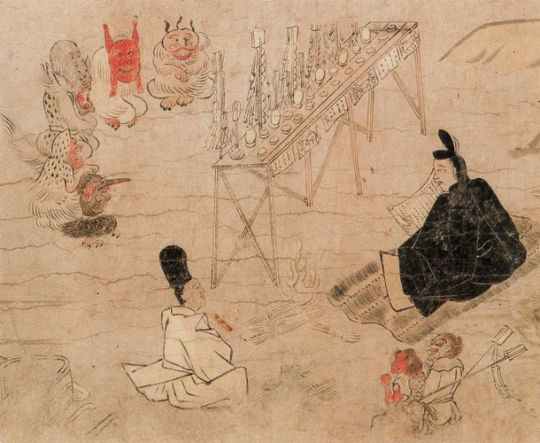
Abe no Seimei exorcising disease spirits (疫病神, yakubyōgami), as depicted in the Fudō Riyaku Engi Emaki. Two creatures who might be shikigami are visible in the bottom right corner (wikimedia commons; identification following Bernard Faure’s Rage and Ravage, pp. 57-58)
In popular culture, shikigami are basically synonymous with onmyōdō. Was this always the case, though? And what is a shikigami, anyway? These questions are surprisingly difficult to answer. I’ve been meaning to attempt to do so for a longer while, but other projects kept getting in the way. Under the cut, you will finally be able to learn all about this matter.
This isn’t just a shikigami article, though. Since historical context is a must, I also provide a brief history of onmyōdō and some of its luminaries. You will also learn if there were female onmyōji, when stars and time periods turn into deities, what onmyōdō has to do with a tale in which Zhong Kui became a king of a certain city in India - and more!
The early days of onmyōdō In order to at least attempt to explain what the term shikigami might have originally entailed, I first need to briefly summarize the history of onmyōdō (陰陽道). This term can be translated as “way of yin and yang”, and at the core it was a Japanese adaptation of the concepts of, well, yin and yang, as well as the five elements. They reached Japan through Daoist and Buddhist sources. Daoism itself never really became a distinct religion in Japan, but onmyōdō is arguably among the most widespread adaptations of its principles in Japanese context.
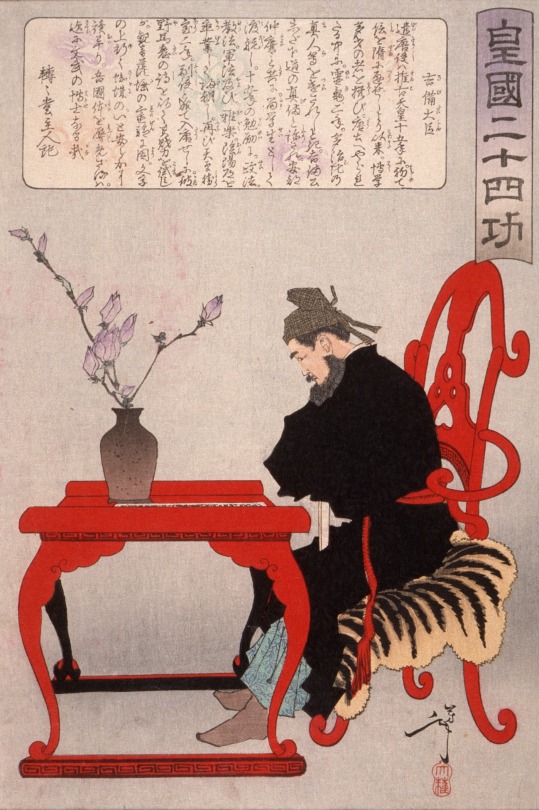
Kibi no Makibi, as depicted by Yoshitoshi Tsukioka (wikimedia commons)
It’s not possible to speak of a singular founder of onmyōdō comparable to the patriarchs of Buddhist schools. Bernard Faure notes that in legends the role is sometimes assigned to Kibi no Makibi, an eighth century official who spent around 20 years in China. While he did bring many astronomical treatises with him when he returned, this is ultimately just a legend which developed long after he passed away.
In reality onmyōdō developed gradually starting with the sixth century, when Chinese methods of divination and treatises dealing with these topics first reached Japan. Early on Buddhist monks from the Korean kingdom of Baekje were the main sources of this knowledge. We know for example that the Soga clan employed such a specialist, a certain Gwalleuk (観勒; alternatively known under the Japanese reading of his name, Kanroku).
Obviously, divination was viewed as a very serious affair, so the imperial court aimed to regulate the continental techniques in some way. This was accomplished by emperor Tenmu with the formation of the onmyōryō (陰陽寮), “bureau of yin and yang” as a part of the ritsuryō system of governance. Much like in China, the need to control divination was driven by the fears that otherwise it would be used to legitimize courtly intrigues against the emperor, rebellions and other disturbances. Officials taught and employed by onmyōryō were referred to as onmyōji (陰陽師). This term can be literally translated as “yin-yang master”. In the Nara period, they were understood essentially as a class of public servants. Their position didn’t substantially differ from that of other specialists from the onmyōryō: calendar makers, officials responsible for proper measurement of time and astrologers. The topics they dealt with evidently weren’t well known among commoners, and they were simply typical members of the literate administrative elite of their times.
Onmyōdō in the Heian period: magic, charisma and nobility
The role of onmyōji changed in the Heian period. They retained the position of official bureaucratic diviners in employ of the court, but they also acquired new duties. The distinction between them and other onmyōryō officials became blurred. Additionally their activity extended to what was collectively referred to as jujutsu (呪術), something like “magic” though this does not fully reflect the nuances of this term. They presided over rainmaking rituals, purification ceremonies, so-called “earth quelling”, and establishing complex networks of temporal and directional taboos.
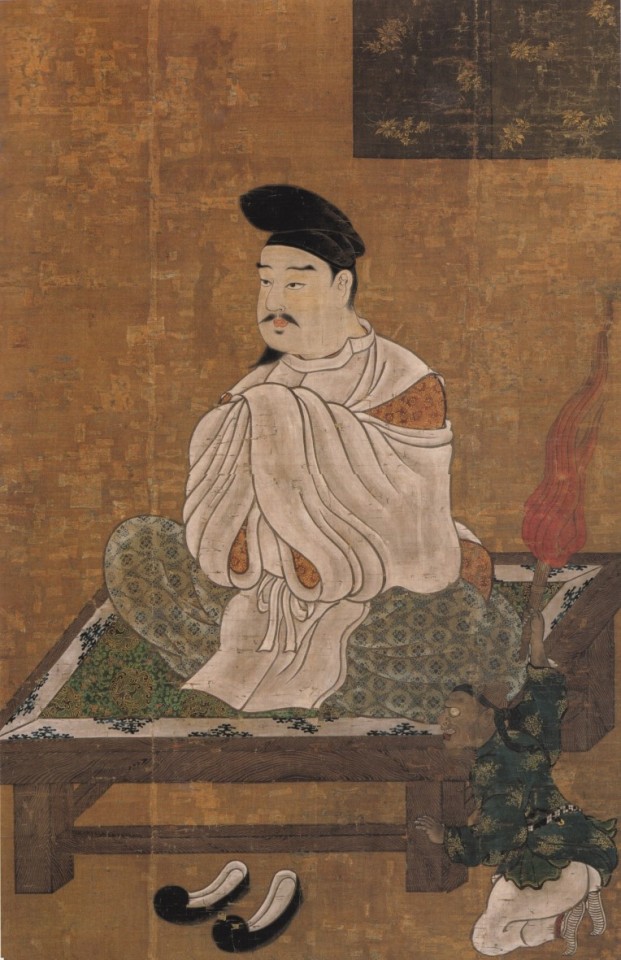
A Muromachi period depiction of Abe no Seimei (wikimedia commons)
The most famous historical onmyōji like Kamo no Yasunori and his student Abe no Seimei were active at a time when this version of onmyōdō was a fully formed - though obviously still evolving - set of practices and beliefs. In a way they represented a new approach, though - one in which personal charisma seemed to matter just as much, if not more, than official position. This change was recognized as a breakthrough by at least some of their contemporaries. For example, according to the diary of Minamoto no Tsuneyori, the Sakeiki (左經記), “in Japan, the foundations of onmyōdō were laid by Yasunori”.
The changes in part reflected the fact that onmyōji started to be privately contracted for various reasons by aristocrats, in addition to serving the state. Shin’ichi Shigeta notes that it essentially turned them from civil servants into tradespeople. However, he stresses they cannot be considered clergymen: their position was more comparable to that of physicians, and there is no indication they viewed their activities as a distinct religion. Indeed, we know of multiple Heian onmyōji, like Koremune no Fumitaka or Kamo no Ieyoshi, who by their own admission were devout Buddhists who just happened to work as professional diviners.
Shin’ichi Shigeta notes is evidence that in addition to the official, state-sanctioned onmyōji, “unlicensed” onmyōji who acted and dressed like Buddhist clergy, hōshi onmyōji (法師陰陽師) existed. The best known example is Ashiya Dōman, a mainstay of Seimei legends, but others are mentioned in diaries, including the famous Pillow Book. It seems nobles particularly commonly employed them to curse rivals. This was a sphere official onmyōji abstained from due to legal regulations. Curses were effectively considered crimes, and government officials only performed apotropaic rituals meant to protect from them. The Heian period version of onmyōdō captivated the imagination of writers and artists, and its slightly exaggerated version present in classic literature like Konjaku Monogatari is essentially what modern portrayals in fiction tend to go back to.
Medieval onmyōdō: from abstract concepts to deities
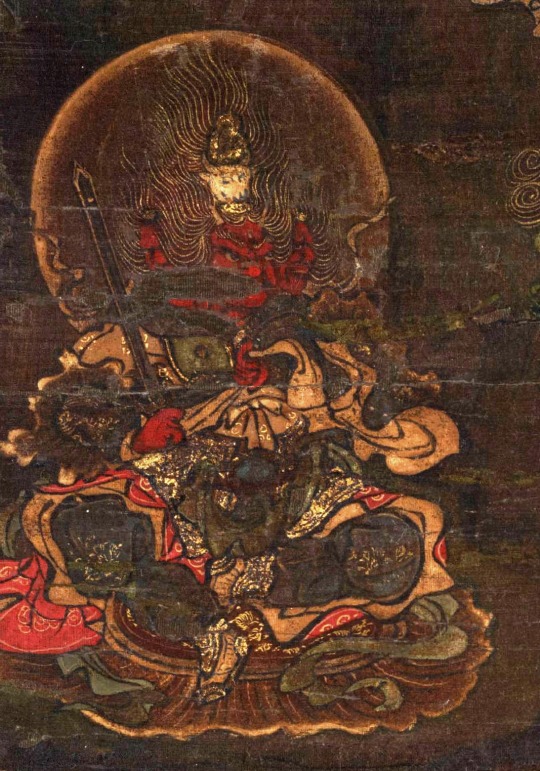
Gozu Tennō (wikimedia commons)
Further important developments occurred between the twelfth and fourteenth centuries. This period was the beginning of the Japanese “middle ages” which lasted all the way up to the establishment of the Tokugawa shogunate. The focus in onmyōdō in part shifted towards new, or at least reinvented, deities, such as calendarical spirits like Daishōgun (大将軍) and Ten’ichijin (天一神), personifications of astral bodies and concepts already crucial in earlier ceremonies. There was also an increased interest in Chinese cosmological figures like Pangu, reimagined in Japan as “king Banko”. However, the most famous example is arguably Gozu Tennō, who you might remember from my Susanoo article.
The changes in medieval onmyōdō can be described as a process of convergence with esoteric Buddhism. The points of connection were rituals focused on astral and underworld deities, such as Taizan Fukun or Shimei (Chinese Siming). Parallels can be drawn between this phenomenon and the intersection between esoteric Buddhism and some Daoist schools in Tang China. Early signs of the development of a direct connection between onmyōdō and Buddhism can already be found in sources from the Heian period, for example Kamo no Yasunori remarked that he and other onmyōji depend on the same sources to gain proper understanding of ceremonies focused on the Big Dipper as Shingon monks do.
Much of the information pertaining to the medieval form of onmyōdō is preserved in Hoki Naiden (ほき内伝; “Inner Tradition of the Square and the Round Offering Vessels”), a text which is part divination manual and part a collection of myths. According to tradition it was compiled by Abe no Seimei, though researchers generally date it to the fourteenth century. For what it’s worth, it does seem likely its author was a descendant of Seimei, though. Outside of specialized scholarship Hoki Naiden is fairly obscure today, but it’s worth noting that it was a major part of the popular perception of onmyōdō in the Edo period. A novel whose influence is still visible in the modern image of Seimei, Abe no Seimei Monogatari (安部晴明物語), essentially revolves around it, for instance.
Onmyōdō in the Edo period: occupational licensing
Novels aside, the first post-medieval major turning point for the history of onmyōdō was the recognition of the Tsuchimikado family as its official overseers in 1683. They were by no means new to the scene - onmyōji from this family already served the Ashikaga shoguns over 250 years earlier. On top of that, they were descendants of the earlier Abe family, the onmyōji par excellence. The change was not quite the Tsuchimikado’s rise, but rather the fact the government entrusted them with essentially regulating occupational licensing for all onmyōji, even those who in earlier periods existed outside of official administration.
As a result of the new policies, various freelance practitioners could, at least in theory, obtain a permit to perform the duties of an onmyōji. However, as the influence of the Tsuchimikado expanded, they also sought to oblige various specialists who would not be considered onmyōji otherwise to purchase licenses from them. Their aim was to essentially bring all forms of divination under their control. This extended to clergy like Buddhist monks, shugenja and shrine priests on one hand, and to various performers like members of kagura troupes on the other.
Makoto Hayashi points out that while throughout history onmyōji has conventionally been considered a male occupation, it was possible for women to obtain licenses from the Tsuchimikado. Furthermore, there was no distinct term for female onmyōji, in contrast with how female counterparts of Buddhist monks, shrine priests and shugenja were referred to with different terms and had distinct roles defined by their gender. As far as I know there’s no earlier evidence for female onmyōji, though, so it’s safe to say their emergence had a lot to do with the specifics of the new system. It seems the poems of the daughter of Kamo no Yasunori (her own name is unknown) indicate she was familiar with yin-yang theory or at least more broadly with Chinese philosophy, but that’s a topic for a separate article (stay tuned), and it's not quite the same, obviously.
The Tsuchimikado didn’t aim to create a specific ideology or systems of beliefs. Therefore, individual onmyōji - or, to be more accurate, individual people with onmyōji licenses - in theory could pursue new ideas. This in some cases lead to controversies: for instance, some of the people involved in the (in)famous 1827 Osaka trial of alleged Christians (whether this label really is applicable is a matter of heated debate) were officially licensed onmyōji. Some of them did indeed possess translated books written by Portuguese missionaries, which obviously reflected Catholic outlook. However, Bernard Faure suggests that some of the Edo period onmyōji might have pursued Portuguese sources not strictly because of an interest in Catholicism but simply to obtain another source of astronomical knowledge.
The legacy of onmyōdō
In the Meiji period, onmyōdō was banned alongside shugendō. While the latter tradition experienced a revival in the second half of the twentieth century, the former for the most part didn’t. However, that doesn’t mean the history of onmyōdō ends once and for all in the second half of the nineteenth century.
Even today in some parts of Japan there are local religious traditions which, while not identical with historical onmyōdō, retain a considerable degree of influence from it. An example often cited in scholarship is Izanagi-ryū (いざなぎ流) from the rural Monobe area in the Kōchi Prefecture. Mitsuki Ueno stresses that the occasional references to Izanagi-ryū as “modern onmyōdō” in literature from the 1990s and early 2000s are inaccurate, though. He points out they downplay the unique character of this tradition, and that it shows a variety of influences. Similar arguments have also been made regarding local traditions from the Chūgoku region.
Until relatively recently, in scholarship onmyōdō was basically ignored as superstition unworthy of serious inquiries. This changed in the final decades of the twentieth century, with growing focus on the Japanese middle ages among researchers. The first monographs on onmyōdō were published in the 1980s. While it’s not equally popular as a subject of research as esoteric Buddhism and shugendō, formerly neglected for similar reasons, it has nonetheless managed to become a mainstay of inquiries pertaining to the history of religion in Japan.
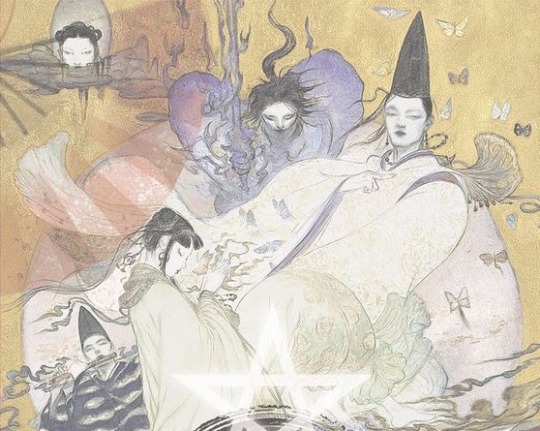
Yoshitaka Amano's illustration of Baku Yumemakura's fictionalized portrayal of Abe no Seimei (right) and other characters from his novels (reproduced here for educational purposes only)
Of course, it’s also impossible to talk about onmyōdō without mentioning the modern “onmyōdō boom”. Starting with the 1980s, onmyōdō once again became a relatively popular topic among writers. Novel series such as Baku Yumemakura’s Onmyōji, Hiroshi Aramata’s Teito Monogatari or Natsuhiko Kyōgoku’s Kyōgōkudō and their adaptations in other media once again popularized it among general audiences. Of course, since these are fantasy or mystery novels, their historical accuracy tends to vary (Yumemakura in particular is reasonably faithful to historical literature, though). Still, they have a lasting impact which would be impossible to accomplish with scholarship alone.
Shikigami: historical truth, historical fiction, or both?
You might have noticed that despite promising a history of shikigami, I haven’t used this term even once through the entire crash course in history of onmyōdō. This was a conscious choice. Shikigami do not appear in any onmyōdō texts, even though they are a mainstay of texts about onmyōdō, and especially of modern literature involving onmyōji.
It would be unfair to say shikigami and their prominence are merely a modern misconception, though. Virtually all of the famous legends about onmyōji feature shikigami, starting with the earliest examples from the eleventh century. Based on Konjaku Monogatari, there evidently was a fascination with shikigami at the time of its compilation. Fujiwara no Akihira in the Shinsarugakuki treats the control of shikigami as an essential skill of an onmyōji, alongside the abilities to “freely summon the twelve guardian deities, call thirty-six types of wild birds (...), create spells and talismans, open and close the eyes of kijin (鬼神; “demon gods”), and manipulate human souls”.
It is generally agreed that such accounts, even though they belong to the realm of literary fiction, can shed light on the nature and importance of shikigami. They ultimately reflect their historical context to some degree. Furthermore, it is not impossible that popular understanding of shikigami based on literary texts influenced genuine onmyōdō tradition. It’s worth pointing out that today legends about Abe no Seimei involving them are disseminated by two contemporary shrines dedicated to him, the Seimei Shrine (晴明神社) in Kyoto and the Abe no Seimei Shrine (安倍晴明神社) in Osaka. Interconnected networks of exchange between literature and religious practice are hardly a unique or modern phenomenon.
However, even with possible evidence from historical literature taken into account, it is not easy to define shikigami. The word itself can be written in three different ways: 式神 (or just 式), 識神 and 職神, with the first being the default option. The descriptions are even more varied, which understandably lead to the rise of numerous interpretations in modern scholarship. Carolyn Pang in her recent treatments of shikigami, which you can find in the bibliography, has recently divided them into five categories. I will follow her classification below.
Shikigami take 1: rikujin-shikisen
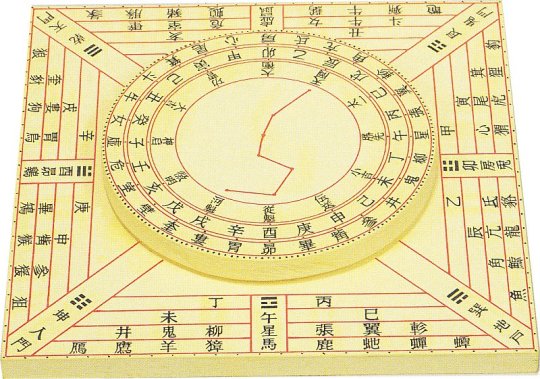
An example of shikiban, the divination board used in rikujin-shikisen (Museum of Kyoto, via onmarkproductions.com; reproduced here for educational purposes only)
A common view is that shikigami originate as a symbolic representation of the power of shikisen (式占) or more specifically rikujin-shikisen (六壬式占), the most common form of divination in onmyōdō. It developed from Chinese divination methods in the Nara period, and remained in the vogue all the way up to the sixteenth century, when it was replaced by ekisen (易占), a method derived from the Chinese Book of Changes.
Shikisen required a special divination board known as shikiban (式盤), which consists of a square base, the “earth panel” (地盤, jiban), and a rotating circle placed on top of it, the “heaven panel” (天盤, tenban). The former was marked with twelve points representing the signs of the zodiac and the latter with representations of the “twelve guardians of the months” (十二月将, jūni-gatsushō; their identity is not well defined). The heaven panel had to be rotated, and the diviner had to interpret what the resulting combination of symbols represents. Most commonly, it was treated as an indication whether an unusual phenomenon (怪/恠, ke) had positive or negative implications. It’s worth pointing out that in the middle ages the shikiban also came to be used in some esoteric Buddhist rituals, chiefly these focused on Dakiniten, Shōten and Nyoirin Kannon. However, they were only performed between the late Heian and Muromachi periods, and relatively little is known about them. In most cases the divination board was most likely modified to reference the appropriate esoteric deities.
Shikigami take 2: cognitive abilities
While the view that shikigami represented shikisen is strengthened by the fact both terms share the kanji 式, a variant writing, 識神, lead to the development of another proposal. Since the basic meaning of 識 is “consciousness”, it is sometimes argued that shikigami were originally an “anthropomorphic realization of the active psychological or mental state”, as Caroline Pang put it - essentially, a representation of the will of an onmyōji. Most of the potential evidence in this case comes from Buddhist texts, such as Bosatsushotaikyō (菩薩処胎経).
However, Bernard Faure assumes that the writing 識神 was a secondary reinterpretation, basically a wordplay based on homonymy. He points out the Buddhist sources treat this writing of shikigami as a synonym of kushōjin (倶生神). This term can be literally translated as “deities born at the same time”. Most commonly it designates a pair of minor deities who, as their name indicates, come into existence when a person is born, and then records their deeds through their entire life. Once the time for Enma’s judgment after death comes, they present him with their compiled records. It has been argued that they essentially function like a personification of conscience.
Shikigami take 3: energy
A further speculative interpretation of shikigami in scholarship is that this term was understood as a type of energy present in objects or living beings which onmyōji were believed to be capable of drawing out and harnessing to their ends. This could be an adaptation of the Daoist notion of qi (氣). If this definition is correct, pieces of paper or wooden instruments used in purification ceremonies might be examples of objects utilized to channel shikigami.
The interpretation of shikigami as a form of energy is possibly reflected in Konjaku Monogatari in the tale The Tutelage of Abe no Seimei under Tadayuki. It revolves around Abe no Seimei’s visit to the house of the Buddhist monk Kuwanten from Hirosawa. Another of his guests asks Seimei if he is capable of killing a person with his powers, and if he possesses shikigami. He affirms that this is possible, but makes it clear that it is not an easy task. Since the guests keep urging him to demonstrate nonetheless, he promptly demonstrates it using a blade of grass. Once it falls on a frog, the animal is instantly crushed to death. From the same tale we learn that Seimei’s control over shikigami also let him remotely close the doors and shutters in his house while nobody was inside.
Shikigami take 4: curse As I already mentioned, arts which can be broadly described as magic - like the already mentioned jujutsu or juhō (呪法, “magic rituals”) - were regarded as a core part of onmyōji’s repertoire from the Heian period onward. On top of that, the unlicensed onmyōji were almost exclusively associated with curses. Therefore, it probably won’t surprise you to learn that yet another theory suggests shikigami is simply a term for spells, curses or both. A possible example can be found in Konjaku Monogatari, in the tale Seimei sealing the young Archivist Minor Captains curse - the eponymous curse, which Seimei overcomes with protective rituals, is described as a shikigami.

Kunisuda Utagawa's illustration of an actor portraying Dōman in a kabuki play (wikimedia commons)
Similarities between certain descriptions of shikigami and practices such as fuko (巫蠱) and goraihō (五雷法) have been pointed out. Both of these originate in China. Fuko is the use of poisonous, venomous or otherwise negatively perceived animals to create curses, typically by putting them in jars, while goraihō is the Japanese version of Daoist spells meant to control supernatural beings, typically ghosts or foxes. It’s worth noting that a legend according to which Dōman cursed Fujiwara no Michinaga on behalf of lord Horikawa (Fujiwara no Akimitsu) involves him placing the curse - which is itself not described in detail - inside a jar.
Mitsuki Ueno notes that in the Kōchi Prefecture the phrase shiki wo utsu, “to strike with a shiki”, is still used to refer to cursing someone. However, shiki does not necessarily refer to shikigami in this context, but rather to a related but distinct concept - more on that later.
Shikigami take 5: supernatural being
While all four definitions I went through have their proponents, yet another option is by far the most common - the notion of shikigami being supernatural beings controlled by an onmyōji. This is essentially the standard understanding of the term today among general audiences. Sometimes attempts are made to identify it with a specific category of supernatural beings, like spirits (精霊, seirei), kijin or lesser deities (下級神, kakyū shin). However, none of these gained universal support. Generally speaking, there is no strong indication that shikigami were necessarily imagined as individualized beings with distinct traits.
The notion of shikigami being supernatural beings is not just a modern interpretation, though, for the sake of clarity. An early example where the term is unambiguously used this way is a tale from Ōkagami in which Seimei sends a nondescript shikigami to gather information. The entity, who is not described in detail, possesses supernatural skills, but simultaneously still needs to open doors and physically travel.
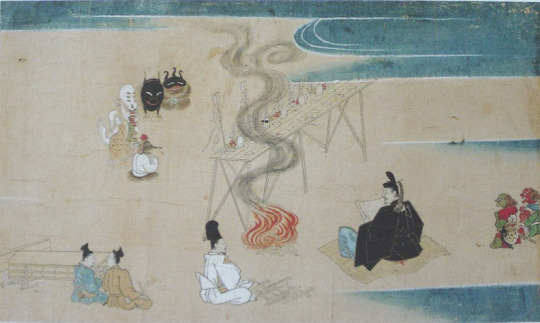
An illustration from Nakifudō Engi Emaki (wikimedia commons)
In Genpei Jōsuiki there is a reference to Seimei’s shikigami having a terrifying appearance which unnerved his wife so much he had to order the entities to hide under a bride instead of residing in his house. Carolyn Pang suggests that this reflects the demon-like depictions from works such as Abe no Seimei-kō Gazō (安倍晴明公画像; you can see it in the Heian section), Fudōriyaku Engi Emaki and Nakifudō Engi Emaki.
Shikigami and related concepts

A gohō dōji, as depicted in the Shigisan Engi Emaki (wikimedia commons)
The understanding of shikigami as a “spirit servant” of sorts can be compared with the Buddhist concept of minor protective deities, gohō dōji (護法童子; literally “dharma-protecting lads”). These in turn were just one example of the broad category of gohō (護法), which could be applied to virtually any deity with protective qualities, like the historical Buddha’s defender Vajrapāṇi or the Four Heavenly Kings. A notable difference between shikigami and gohō is the fact that the former generally required active summoning - through chanting spells and using mudras - while the latter manifested on their own in order to protect the pious. Granted, there are exceptions. There is a well attested legend according to which Abe no Seimei’s shikigami continued to protect his residence on own accord even after he passed away. Shikigami acting on their own are also mentioned in Zoku Kojidan (続古事談). It attributes the political downfall of Minamoto no Takaakira (源高明; 914–98) to his encounter with two shikigami who were left behind after the onmyōji who originally summoned them forgot about them.
A degree of overlap between various classes of supernatural helpers is evident in texts which refer to specific Buddhist figures as shikigami. I already brought up the case of the kushōjin earlier. Another good example is the Tendai monk Kōshū’s (光宗; 1276–1350) description of Oto Gohō (乙護法). He is “a shikigami that follows us like the shadow follows the body. Day or night, he never withdraws; he is the shikigami that protects us” (translation by Bernard Faure). This description is essentially a reversal of the relatively common title “demon who constantly follow beings” (常随魔, jōzuima). It was applied to figures such as Kōjin, Shōten or Matarajin, who were constantly waiting for a chance to obstruct rebirth in a pure land if not placated properly.
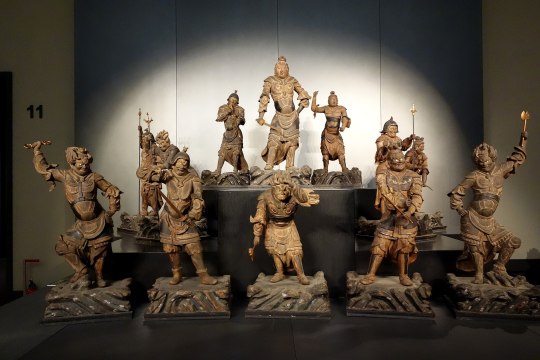
The Twelve Heavenly Generals (Tokyo National Museum, via wikimedia commons)
A well attested group of gohō, the Twelve Heavenly Generals (十二神将, jūni shinshō), and especially their leader Konpira (who you might remember from my previous article), could be labeled as shikigami. However, Fujiwara no Akihira’s description of onmyōji skills evidently presents them as two distinct classes of beings.
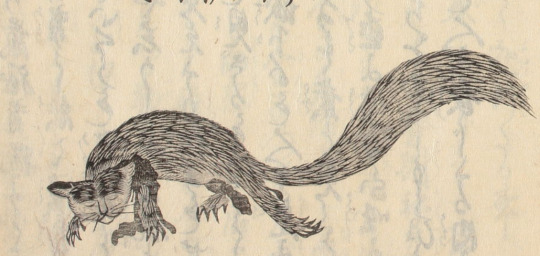
A kuda-gitsune, as depicted in Shōzan Chomon Kishū by Miyoshi Shōzan (Waseda University History Museum; reproduced here for educational purposes only)
Granted, Akihira also makes it clear that controlling shikigami and animals are two separate skills. Meanwhile, there is evidence that in some cases animal familiars, especially kuda-gitsune used by iizuna (a term referring to shugenja associated with the cult of, nomen omen, Iizuna Gongen, though more broadly also something along the lines of “sorcerer”), were perceived as shikigami.
Beliefs pertaining to gohō dōji and shikigami seemingly merged in Izanagi-ryū, which lead to the rise of the notion of shikiōji (式王子; ōji, literally “prince”, can be another term for gohō dōji). This term refers to supernatural beings summoned by a ritual specialist (祈祷師, kitōshi) using a special formula from doctrinal texts (法文, hōmon). They can fulfill various functions, though most commonly they are invoked to protect a person, to remove supernatural sources of diseases, to counter the influence of another shikiōji or in relation to curses.
Tenkeisei, the god of shikigami

Tenkeisei (wikimedia commons)
The final matter which warrants some discussion is the unusual tradition regarding the origin of shikigami which revolves around a deity associated with this concept.
In the middle ages, a belief that there were exactly eighty four thousand shikigami developed. Their source was the god Tenkeisei (天刑星; also known as Tengyōshō). His name is the Japanese reading of Chinese Tianxingxing. It can be translated as “star of heavenly punishment”. This name fairly accurately explains his character. He was regarded as one of the so-called “baleful stars” (凶星, xiong xing) capable of controlling destiny. The “punishment” his name refers to is his treatment of disease demons (疫鬼, ekiki). However, he could punish humans too if not worshiped properly.
Today Tenkeisei is best known as one of the deities depicted in a series of paintings known as Extermination of Evil, dated to the end of the twelfth century. He has the appearance of a fairly standard multi-armed Buddhist deity. The anonymous painter added a darkly humorous touch by depicting him right as he dips one of the defeated demons in vinegar before eating him. Curiously, his adversaries are said to be Gozu Tennō and his retinue in the accompanying text. This, as you will quickly learn, is a rather unusual portrayal of the relationship between these two deities.
I’m actually not aware of any other depictions of Tenkeisei than the painting you can see above. Katja Triplett notes that onmyōdō rituals associated with him were likely surrounded by an aura of secrecy, and as a result most depictions of him were likely lost or destroyed. At the same time, it seems Tenkeisei enjoyed considerable popularity through the Kamakura period. This is not actually paradoxical when you take the historical context into account: as I outlined in my recent Amaterasu article, certain categories of knowledge were labeled as secret not to make their dissemination forbidden, but to imbue them with more meaning and value.
Numerous talismans inscribed with Tenkeisei’s name are known. Furthermore, manuals of rituals focused on him have been discovered. The best known of them, Tenkeisei-hō (天刑星法; “Tenkeisei rituals”), focuses on an abisha (阿尾捨, from Sanskrit āveśa), a ritual involving possession by the invoked deity. According to a legend was transmitted by Kibi no Makibi and Kamo no Yasunori. The historicity of this claim is doubtful, though: the legend has Kamo no Yasunori visit China, which he never did. Most likely mentioning him and Makibi was just a way to provide the text with additional legitimacy.
Other examples of similar Tenkeisei manuals include Tenkeisei Gyōhō (天刑星行法; “Methods of Tenkeisei Practice”) and Tenkeisei Gyōhō Shidai (天刑星行法次第; “Methods of Procedure for the Tenkeisei Practice”). Copies of these texts have been preserved in the Shingon temple Kōzan-ji.
The Hoki Naiden also mentions Tenkeisei. It equates him with Gozu Tennō, and explains both of these names refer to the same deity, Shōki (商貴), respectively in heaven and on earth. While Shōki is an adaptation of the famous Zhong Kui, it needs to be pointed out that here he is described not as a Tang period physician but as an ancient king of Rajgir in India. Furthermore, he is a yaksha, not a human. This fairly unique reinterpretation is also known from the historical treatise Genkō Shakusho. Post scriptum The goal of this article was never to define shikigami. In the light of modern scholarship, it’s basically impossible to provide a single definition in the first place. My aim was different: to illustrate that context is vital when it comes to understanding obscure historical terms. Through history, shikigami evidently meant slightly different things to different people, as reflected in literature. However, this meaning was nonetheless consistently rooted in the evolving perception of onmyōdō - and its internal changes. In other words, it reflected a world which was fundamentally alive. The popular image of Japanese culture and religion is often that of an artificial, unchanging landscape straight from the “age of the gods”, largely invented in the nineteenth century or later to further less than noble goals. The case of shikigami proves it doesn’t need to be, though. The malleable, ever-changing image of shikigami, which remained a subject of popular speculation for centuries before reemerging in a similar role in modern times, proves that the more complex reality isn’t necessarily any less interesting to new audiences.
Bibliography
Bernard Faure, A Religion in Search of a Founder?
Idem, Rage and Ravage (Gods of Medieval Japan vol. 3)
Makoto Hayashi, The Female Christian Yin-Yang Master
Jun’ichi Koike, Onmyōdō and Folkloric Culture: Three Perspectives for the Development of Research
Irene H. Lin, Child Guardian Spirits (Gohō Dōji) in the Medieval Japanese Imaginaire
Yoshifumi Nishioka, Aspects of Shikiban-Based Mikkyō Rituals
Herman Ooms, Yin-Yang's Changing Clientele, 600-800 (note there is n apparent mistake in one of the footnotes, I'm pretty sure the author wanted to write Mesopotamian astronomy originated 4000 years ago, not 4 millenia BCE as he did; the latter date makes little sense)
Carolyn Pang, Spirit Servant: Narratives of Shikigami and Onmyōdō Developments
Idem, Uncovering Shikigami. The Search for the Spirit Servant of Onmyōdō
Shin’ichi Shigeta, Onmyōdō and the Aristocratic Culture of Everyday Life in Heian Japan
Idem, A Portrait of Abe no Seimei
Katja Triplett, Putting a Face on the Pathogen and Its Nemesis. Images of Tenkeisei and Gozutennō, Epidemic-Related Demons and Gods in Medieval Japan
Mitsuki Umeno, The Origins of the Izanagi-ryū Ritual Techniques: On the Basis of the Izanagi saimon
Katsuaki Yamashita, The Characteristics of On'yōdō and Related Texts
199 notes
·
View notes
Text

Game Art Master Classes in India
Game Art Master Classes in India offer aspiring game artists a unique opportunity to hone their skills and learn from industry professionals. Institutes like 3D Mojito provide hands-on training using the latest tools and techniques, helping students master 3D modeling, texturing, and other essential game art skills. These master classes are perfect for artists looking to advance their careers in the dynamic world of game design.
#Game Art Master Classes in India#Game Art Master Classes#Master Classes#Master Classes Online#game art
1 note
·
View note
Text





This Band Thought Their Biggest Hurdle Was the Patriarchy. It’s Actually the Internet.
By Safina Nabi
October 25, 2021
In almost every way, the tiny village of Ganasthan seems cut off. The closest big city, Srinagar, is a two-hour drive away. The main road that snakes through it is so narrow that most people are forced to walk two to three miles to get home.
Surrounded by tall pine trees that are hundreds of years old, most villagers busy themselves with the yellow paddy fields ready to be harvested, but the all-women band Yemberzal are practicing their distinctly traditional Sufiyana music at home and recording their sessions on their mobile phones.
They’re at a band member’s home made of mud, brick and wood – a traditional house no longer found in other parts of Indian-administered Kashmir. Despite being remote and traditional, the village has been connected to the rest of the world through mobile phones for years.
That is, until the internet blackouts that have driven the region of 12 million people into isolation.
“It’s been so long that we haven’t seen or performed on a stage. If you see other parts of the world, there are online music concerts, classes, but in Kashmir, nothing happens,“ said 22 year-old Gulshan Lateef, a member of Yemberzal, which last performed in 2019.
In August 2019, the Indian government revoked a 1948 UN resolution that gave Jammu and Kashmir autonomy as the only Muslim-majority state in India, and started one of the longest internet bans in history. It was restored in February of 2020, but internet outages have been frequent and unpredictable since then. A recent spate of violence prompted the government to cut the internet in the region yet again. This writer too had to ultimately resort to social messaging to submit this story when it proved too difficult to use email or other cloud sharing platforms.
Lateef and Irfana Yousuf, another 22-year-old Sufi musician, grew up with the internet easily accessible on their families’ mobile phones.
As soon as Yousuf was introduced to the basics of Sufiyana Mausiqi by her father, she knew she wanted to keep the dying art form alive by connecting with audiences on the internet. But first she had to formally learn the classic Islamic mystical music genre that is almost exclusively dominated by men, has unique instruments and is on the verge of extinction in Kashmir.
Experts say there are only four master teachers or ustads left in Kashmir who teach this ancient genre that is believed to have been born in the 15th century. Yusuf enrolled in a music course at the University of Kashmir in Srinagar to learn from one of them.
Her mission is to revive the dying genre of devotional music by preserving it and reviving its audiences through social media.
Read More
#long post#kashmir#Safina Nabi#women#youth#Ganasthan#Gulshan Lateef#Yemberzal#Irfana Yousuf#sufi#tradition#instruments#Saaz-e-Kashmir#santoor#dulcimer#tabla#drums#Riahana Yousuf#Shubnam Bashir
20 notes
·
View notes
Photo

Missouri Compromise
The Missouri Compromise of 1820 was an effort by the US Congress to resolve a sectional dispute between the 'free states' of the North and the 'slave states' of the South. Hoping to hinder the westward expansion of slavery – and thereby limit the undue political influence of the slave-holding South – Northern representatives had sought to deny Missouri admittance into the Union unless it limited slavery within its borders. This was hotly opposed by Southern representatives, leading to the compromise: Missouri would enter the Union as a 'slave state' in exchange for the admittance of Maine as a 'free state', as well as the prohibition of slavery in all western lands north of the 36°30′ parallel, excluding Missouri itself. While this provided a temporary solution, the question of slavery would only become more contested, eventually leading to the American Civil War (1861-1865).
Background: An Empire of Slavery
By 1815, 1.4 million men, women, and children languished in a state of perpetual and hereditary bondage in the United States, the legal property of their masters. The institution of slavery was an undoubtedly hideous blight on what President Thomas Jefferson (1743-1826) had once called the 'empire of liberty'; indeed, in the years that followed the American Revolution (1765-1789) many White Americans recognized that slavery was incompatible with the Enlightenment ideals upon which their country was founded, summed up by the famous phrase 'all men are created equal'. Some slaveholders, like Jefferson himself, agreed that slavery was a moral evil but were worried that a general emancipation would have grave consequences – not only would the immediate release of all slaves threaten the White supremacy from which the slave-holding class derived its power, but it could also provoke insurrection, as some of the former slaves might seek retaliatory vengeance on their erstwhile masters. Poorer White Americans were also unwilling to be taxed so that the slaveholders could be compensated for freeing their slaves.
And so, the Founders reluctantly sanctioned slavery, but with the implicit understanding that it would be gradually eradicated over time. Their commitment to this goal was manifest in several pieces of legislation – in 1787, Congress passed the Northwest Ordinance, which prohibited the expansion of slavery into the vast Northwest Territory, and the trans-Atlantic slave trade was abolished in 1807. The regulation of slavery in areas where it already existed was left to the states, but even here, there were great strides toward emancipation. Pennsylvania and the states of New England had already abolished slavery during the Revolution, while New York and New Jersey each began processes of gradual emancipation around the turn of the century. Diversified methods of farming in the Upper South left that region less dependent on slavery, causing an increased rate of individual slaveholders freeing their slaves in Delaware, Maryland, and Virginia. By the end of the 18th century, the institution of slavery was on decline everywhere in the United States except South Carolina and Georgia. Racism, of course, was still prevalent, and free Blacks were rarely regarded as equal. But there was still reason to hope that within only a few generations, slavery would have died a natural death, a bleak chapter in the otherwise glowing history of Jefferson's 'empire of liberty'.
But it was not long before this wave of emancipation came to an abrupt and screeching halt. The destruction wrought by the Napoleonic Wars (1804-1815) in Europe had disrupted international commerce for nearly a generation and had prevented the mass marketing of products like cotton. In the American South, where the climate was ideal for cotton growth, planters seized the opportunity to pick up the slack. By 1820, the United States had replaced India as the largest cotton producer in the world and would provide 68% of the world's cotton by 1850. But cotton cultivation was a labor-intensive process, even after the invention of the cotton gin; consequently, the interstate slave trade roared to life again, as planters rushed to buy slaves to toil on their cotton plantations. To justify this reversal, slaveholders no longer claimed that slavery was a moral evil. Instead, they claimed that they were paternalistic caretakers who treated their slaves better than Northern industrialists treated their wage workers.
More and more White settlers travelled west with their slaves, headed for the cotton-friendly regions of the southwestern Louisiana Purchase. In 1812, the state of Louisiana joined the Union as a 'slave state,' and just like that, the westward spread of slavery increased its momentum. Though there was not yet a clear distinction between the 'free states' of the North and the 'slave states' of the South – many Northern states were still in the process of weaning off slavery – the cultural differences between the two regions were already beginning to take shape. The industrializing North and the agrarian South had been feuding over the soul of the nation since the days of Alexander Hamilton and Thomas Jefferson's arguments in President George Washington's cabinet meetings. But now, the institution of slavery festered beneath the nation's surface like a tumor, poised to spread throughout the body of the nation – the only question was whether the nation would ignore it until it was too late.
Read More
⇒ Missouri Compromise
#History#ThomasJefferson#MissouriCompromise#AmericanCivilWar#HenryClay#Slavery#TallmadgeAmendment#USHistory#WHE
19 notes
·
View notes
Text
Manifesto of the Communist Party
[ Table of Contents | Next ▹ ]
A spectre is haunting Europe – the spectre of communism. All the powers of old Europe have entered into a holy alliance to exorcise this spectre: Pope and Tsar, Metternich and Guizot, French Radicals and German police-spies.
Where is the party in opposition that has not been decried as communistic by its opponents in power? Where is the opposition that has not hurled back the branding reproach of communism, against the more advanced opposition parties, as well as against its reactionary adversaries?
Two things result from this fact:
Communism is already acknowledged by all European powers to be itself a power.
It is high time that Communists should openly, in the face of the whole world, publish their views, their aims, their tendencies, and meet this nursery tale of the Spectre of Communism with a manifesto of the party itself.
To this end, Communists of various nationalities have assembled in London and sketched the following manifesto, to be published in the English, French, German, Italian, Flemish and Danish languages.
I. Bourgeois and Proletarians*
* By bourgeoisie is meant the class of modern capitalists, owners of the means of social production and employers of wage labour. By proletariat, the class of modern wage labourers who, having no means of production of their own, are reduced to selling their labour power in order to live. [Engels, 1888 English edition]
The history of all hitherto existing society† is the history of class struggles.
† That is, all written history. In 1847, the pre-history of society, the social organisation existing previous to recorded history, all but unknown. Since then, August von Haxthausen (1792-1866) discovered common ownership of land in Russia, Georg Ludwig von Maurer proved it to be the social foundation from which all Teutonic races started in history, and, by and by, village communities were found to be, or to have been, the primitive form of society everywhere from India to Ireland. The inner organisation of this primitive communistic society was laid bare, in its typical form, by Lewis Henry Morgan's (1818-1861) crowning discovery of the true nature of the gens and its relation to the tribe. With the dissolution of the primeval communities, society begins to be differentiated into separate and finally antagonistic classes. I have attempted to retrace this dissolution in The Origin of the Family, Private Property, and the State, second edition, Stuttgart, 1886. [Engels, 1888 English Edition and 1890 German Edition (with the last sentence omitted)]
Freeman and slave, patrician and plebeian, lord and serf, guild-master‡ and journeyman, in a word, oppressor and oppressed, stood in constant opposition to one another, carried on an uninterrupted, now hidden, now open fight, a fight that each time ended, either in a revolutionary reconstitution of society at large, or in the common ruin of the contending classes.
‡ Guild-master, that is, a full member of a guild, a master within, not a head of a guild. [Engels, 1888 English Edition]
Our epoch, the epoch of the bourgeoisie, possesses, however, this distinct feature: it has simplified class antagonisms. Society as a whole is more and more splitting up into two great hostile camps, into two great classes directly facing each other – Bourgeoisie and Proletariat.
From the serfs of the Middle Ages sprang the chartered burghers of the earliest towns. From these burgesses the first elements of the bourgeoisie were developed.
The discovery of America, the rounding of the Cape, opened up fresh ground for the rising bourgeoisie. The East-Indian and Chinese markets, the colonisation of America, trade with the colonies, the increase in the means of exchange and in commodities generally, gave to commerce, to navigation, to industry, an impulse never before known, and thereby, to the revolutionary element in the tottering feudal society, a rapid development.
The Communist Manifesto - Part 1
[ Table of Contents | Next ▹ ]
52 notes
·
View notes
Note
AITAH for telling my ex's mom I didn't marry her son because they were 'trashy' and 'poor'?
I (25f) come from an upper-middle-class Indian family. In our community, class and status matter a lot, and not marrying into your class or up often means you get disowned. I know it's regressive, but I have never dated anyone without telling them first hand and I have always known what background they came from so that I wouldn't get shamed in our community and neither would my parents. It's a norm, and one of the few I follow, because I can't put any more stress into my elderly parent's lives.
My ex and I broke up last year. We both studied in the same Uni abroad for our Master's and both of us stayed behind in the country. Being from the same community, we bonded over both of us speaking our mother tongue. I told him, the moment he asked me out, that I date to marry, and I would never marry someone my parents wouldn't approve of. I don't care if I sound conservative, I won't. They work very hard to give me a life of privilege and I won't make it hard for them. He reassured me of his family background and the idiot I was trusted him and didn't check. We lived separately anyway, and he was on scholarships and jobs like many of our friends, so I never bothered thinking otherwise. A year into dating he proposes marriage. I told him I wouldn't marry without travelling first. Plus I was thinking of going back to school for a second degree. Then he gaslights me on how I can live my life being married and doing all these things. My friends back home, to whom I told all this, ran a background check, and because we were from the same city, his lies came out.
Truthfully, he came from a family I could never marry into. Not only that, even though my family's conditions were to marry within our economic class, no matter what race or caste, his family came from a place where the veil for women (purdah), not working, and horrible living conditions were prevalent. He lied about his parents being government workers, only one of them had a high school diploma, and in India, it is considered a very bad thing. I confronted him, and we had a massive fight. He told me he would never even look in his family's direction again if I married him, and I was disgusted. I broke up with him, and he harassed me for months. He only stopped when my cousin went to his flat to talk to him, and I don't know what they talked about, but he stopped calling and texting me.
Only, yesterday I got a call from his mother (I'm back in India to celebrate festivals with my family), and she started to cry and tell me that her son blames them for me leaving him. I asked her where she got my number from and she said that he gave it to her. I was pissed, so I asked her to leave me alone, and she started to scream at me and call me names and asked me why wasn't her son enough, and why was marrying into a poor family so bad. So I told her that both she and her son were trashy and I wasn't going to suffer them, that them being poor was not my fault, and to never contact me again. She cried and cursed me.
I don't know, I feel bad, because maybe my ex hurt his mother and she was just mad and took it out on me. AITAH?
#thank you for the submission!#Minor spelling error oh- 😫😫💔 (party not part)#polls#aita#tumblr polls#aita polls#aitah polls#poll blog#aitah#am i the asshole#random polls#poll#tw classism
16 notes
·
View notes
Text
Niranjan Hiranandani’s Vision for Panvel: Pioneering a New Era of Urban Living

Panvel is rapidly emerging as the next major hub for urban development, thanks to the Mumbai 3.0 expansion. As the gateway to Navi Mumbai, Panvel is benefiting from large-scale infrastructure projects, improved connectivity, and growing commercial opportunities. Recognizing its immense potential, Dr Niranjan Hiranandani has played a key role in transforming Panvel’s real estate landscape through Hiranandani Communities. With a focus on sustainability, integrated living, and modern infrastructure, Hiranandani Fortune City has redefined urban development in Panvel, creating a thriving township that blends convenience with quality of life.
Why Panvel? Understanding the Growth Potential
Panvel has become a preferred location for homebuyers, businesses, and investors due to its strategic connectivity and infrastructure expansion. Located near the Mumbai-Pune Expressway, Navi Mumbai International Airport, and JNPT, Panvel is set to become a high-growth corridor.
Several key infrastructure projects, such as the Mumbai Trans-Harbour Link (MTHL) and the Navi Mumbai Metro, are further enhancing Panvel real estate growth. The Panvel-Karjat Rail Corridor, RORO Services, and Coastal Road will ensure seamless connectivity, making the region attractive for professionals and businesses looking for a smart township in Panvel.
Hiranandani’s Master Plan for Panvel: A Smart & Sustainable Township
Dr. Niranjan Hiranandani envisions Panvel as a self-sufficient urban ecosystem. Hiranandani Fortune City, one of the largest Hiranandani Communities projects, is designed as a mixed-use development, integrating premium luxury apartments in Panvel, corporate parks, retail spaces, and entertainment hubs.
Sustainability is at the heart of the township, with eco-friendly architecture, green spaces, and energy-efficient infrastructure. By blending modern urban planning with environmental consciousness, Hiranandani Fortune City offers a model for future real estate developments in India.
Sustainable Living: A Core Element of Hiranandani Panvel
Hiranandani Panvel prioritizes eco-friendly living with initiatives like rainwater harvesting, sewage treatment plants, and renewable energy solutions. Smart design elements, such as tree-lined avenues, landscaped parks, and recreational zones, create a balanced and healthy environment for residents.
By incorporating green building materials and efficient water management systems, Hiranandani Fortune City aligns with global sustainability goals while offering residents a comfortable and environmentally responsible lifestyle.
Enhancing Connectivity: Making Panvel a Well-Connected Urban Hub
Seamless connectivity is a crucial aspect of Niranjan Hiranandani’s vision for Panvel. Upcoming infrastructure projects, such as the Navi Mumbai Metro, MTHL, and new highway expansions, will enhance accessibility to Mumbai and surrounding economic centers.
The expansion of railway stations and metro connectivity will significantly reduce travel time, making Hiranandani Fortune City an attractive location for professionals working in Mumbai, Navi Mumbai, and Pune. As urban development in Panvel accelerates, the township will be at the center of this transformation.
Luxury & Convenience: Redefining Urban Living in Panvel
Hiranandani Fortune City is designed to offer a premium lifestyle with top-tier amenities. Residents enjoy access to world-class clubhouses, modern fitness centers, swimming pools, and landscaped gardens. The township also features high-street retail, ensuring that daily conveniences are within reach.
Additionally, the presence of corporate workspaces and IT hubs makes Hiranandani Panvel a preferred choice for professionals seeking a well-balanced work-life experience. With residential, commercial, and recreational spaces integrated within the township, it exemplifies modern urban planning.
The Economic Impact: Panvel as a Thriving Business & Investment Destination
Under Dr. Niranjan Hiranandani’s leadership, Hiranandani Communities has played a pivotal role in shaping Panvel’s economic landscape. Special Economic Zones (SEZs) and IT parks are flourishing, creating thousands of employment opportunities.
Retail spaces within Hiranandani Fortune City are witnessing rising footfall, and commercial establishments are seeing increased demand. Investors are recognizing Hiranandani Panvel as a high-growth real estate destination, thanks to its long-term capital appreciation and rising rental demand.
What’s Next for Hiranandani’s Vision in Panvel?
Looking ahead, Hiranandani Communities plans to expand Hiranandani Fortune City further, integrating smart city solutions, AI-driven infrastructure, and digital connectivity. With continued investment in sustainable urban planning, the township will evolve to meet the demands of the next generation.
Dr. Niranjan Hiranandani envisions Panvel as a global urban destination, offering a balanced, future-ready lifestyle for residents and businesses. As more infrastructure projects are completed, Hiranandani Fortune City will continue to be at the forefront of Panvel real estate growth.
Conclusion: A New Era of Urban Excellence in Panvel
Dr. Niranjan Hiranandani has transformed Hiranandani Panvel into a benchmark for smart townships in Panvel. With a focus on sustainability, connectivity, and quality of life, Hiranandani Fortune City is not just a residential township but a self-sufficient urban ecosystem.
As Panvel real estate growth continues, Hiranandani Communities remains committed to building luxury apartments in Panvel that offer a world-class living experience. With its strategic location, strong infrastructure, and sustainable development model, Hiranandani Panvel is set to become one of the most sought-after real estate destinations in India.
FAQs
1. What is Niranjan Hiranandani’s vision for Panvel’s future?
Dr. Niranjan Hiranandani envisions Panvel as a smart, sustainable urban hub with world-class residential, commercial, and infrastructure developments.
2. How does Hiranandani Fortune City contribute to Panvel’s development?
Hiranandani Fortune City is a mixed-use township that integrates residential, commercial, and recreational spaces, promoting sustainable and integrated urban growth.
3. Why is Panvel becoming an investment hotspot?
With upcoming projects like the Mumbai Trans-Harbour Link, Navi Mumbai Metro, and new business parks, Panvel is experiencing rapid infrastructure development, making it an attractive investment location.
4. What sustainability initiatives are part of Niranjan Hiranandani’s projects?
Hiranandani Communities incorporates rainwater harvesting, energy-efficient designs, green spaces, and eco-friendly construction materials to promote sustainable urban living.
5. How will Panvel’s connectivity improve in the coming years?
Panvel will see improved connectivity with the Mumbai Metro, enhanced railway corridors, and expressway expansions, reducing travel time to key business districts.
9 notes
·
View notes